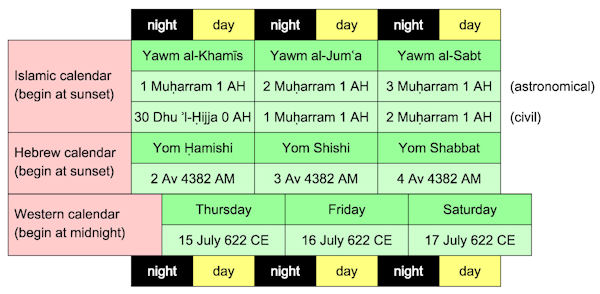
When this web page is loaded the calendar converter will output the current calendar date and weekday. The displayed date can be set manually to any other calendar date by using the +/- buttons.
The well-known Islamic calendar conversion tables first published by Heinrich Ferdinand Wüstenfeld (Vergleichungs-Tabellen der Muhammedanischen und Christlichen Zeitrechnung, 1854; augmented and revised in 1887 and 1926 by Eduard Mahler; third revised and augmented edition by Joachim Mayr and Bertold Spuler in 1961) are based on intercalation type IIc.
The date in the (Julian) solar calendar, commonly known as the Rūmī calendar or the calendar of the Greeks, is also displayed. Years in this calendar, which until fairly recent times was commonly used in Islamic astronomical and historical texts, are counted from the start of the Seleucid Era (SE) which was erroneously believed to coincide with the death of Alexander the Great. The epoch of the Seleucid era, set eleven years after the death of Alexander the Great, actually marked the re-conquest of Babylon by Seleucus I Nicator.
From 1677 CE onwards the number of the Ottoman fiscal year (Sene-i Maliye or Sene-i Rumiya), which started on 1 March (Julian), is also displayed between square brackets. In this reckoning the solar year and the Islamic year numbering were kept in close synchronism by skipping a year in every 32/33 years. Skipped years were 1121 (in 1710 CE), 1154 (in 1742 CE), 1188 (in 1775 CE), 1221 (in 1807 CE) and 1255 (in 1840 CE). After 1872 CE, when the Maliye year 1288 should have been skipped, the Maliye year number was no longer adjusted to (approximately) match the Islamic year number. In 1917 CE the Julian calendar was replaced by the Gregorian calendar and the start of the fiscal year was changed to 1 January. From 1926 CE onwards the Maliye year numbering was abandoned and replaced by the Gregorian year number which was commonly referred to as the Western or International year number.
Calendar dates are also provided for the non-intercalated Egyptian calendar and the Yazdigird calendar as they are often used in Islamic astronomical texts. In the former calendar years are counted from the accession of the Babylonian king Nabonassar and, between square brackets, the reign of Alexander the Great’s successor Philip III Arrhidaeus. In the latter calendar years are counted from the accession of the Sasanid ruler Yazdigird III.
Another solar calendar sometimes referred to is the Alexandrian or Coptic calendar. In this calendar years are counted from the so-called “Era of Martyrs” (anno martyrum or AM), the first year of the reign of the Roman emperor Diocletian. The year in the 15-year indiction cycle is given between square brackets.
As the Islamic day begins at sunset, the Islamic dates given by this calendar converter actually begin at sunset of the previous Western calendar date.
Further note that the dates obtained with this Islamic calendar converter can differ up to two days from calendars based on the true (or computed) visual sighting of the lunar crescent.
Also note that this Islamic calendar converter should not be used before 10 AH (631/632 CE), the year when the intercalation of extra months in the Arabian calendar was abolished (Qurʾān, sūra 9:36-37). A more detailed discussion of this issue can be found in the section Note on early-Islamic chronology.